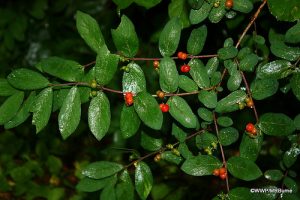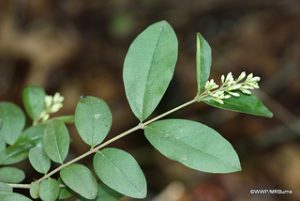Bush Honeysuckle
(Lonucera maackii, Lonicera morrowii, Lonicera tatarica, Lonicera x bella)
Family: Honeysuckle family (Caprifoliaceae)
Native Range: Eurasia

Overview: Deciduous shrubs
Size: 6-15 ft tall
Leaves: 1-2 ½ inch, egg-shaped leaves are opposite along the stem and short-stalked
Stem/Bark: Older stems are often hollow, unlike the native bush honeysuckles which are solid.
Flowers: Pairs of fragrant, tubular flowers less than an inch long are borne along the stem in the leaf axils. Flower color varies from creamy white to pink or crimson in some varieties of Tartarian honeysuckle. Flowering generally occurs from early to late spring, but varies for each species and cultivar.
Seed/Fruit: The fruits are red to orange, many-seeded berries.
Roots: Fibrous
Reproduction: Birds feed on the persistent fruits and widely disseminate seeds across the landscape. In established populations, vegetative sprouting also aids in the persistence of these exotic shrubs
Ecological Threat
- Form a dense shrub layer that crowds and shades out native plant species.
- They alter habitats by decreasing light availability, by depleting soil moisture and nutrients, and possibly by releasing toxic chemicals that prevent other plant species from growing in the vicinity.
- The fruits of exotic bush honeysuckles, while abundant and rich in carbohydrates, do not offer migrating birds the high-fat, nutrient-rich food sources needed for long flights, that are provided by native plant species.
Distribution and Background
Exotic bush honeysuckles were introduced as ornamentals for wildlife cover and for soil erosion control.
Invasive honeysuckle range covers most of the central and eastern United States, and they are distributed throughout New England. Exotic bush honeysuckles are
Habitat Type
Relatively shade-intolerant and most often occurs in forest edges, abandoned fields, pastures, roadsides and other open and disturbed upland habitats. Morrow’s honeysuckle and pretty honeysuckle have the greatest habitat breadth and are capable of invading bogs, fens, lakeshores, sand plains and other uncommon habitat types.
 Management Options
Management Options
Mechanical and chemical methods are the primary means of control of exotic bush honeysuckles. Remove established individuals before they create seed and pull new seedlings as they germinate.
Biological
No biological control available.
Manual and Mechanical
Remove seedlings or small plants by hand for light infestations, taking care not to disturb the soil. In shaded forest habitats, cut to ground level at least once every year during the growing season. Tools such as spades, digging forks, and Weed Wrenches can be effective in removing all but the largest honeysuckles.
Prescribed burning can be effective for controlling exotic bush honeysuckles growing in open habitats.
Chemical
Application of a systemic herbicide like glyphosate (such as Roundup®) is effective in controlling seedlings of exotic bush honeysuckles. Spray a 1 percent solution onto the foliage or apply with a sponge. For larger shrubs, cut the stems to ground level and immediately paint or spray the stumps with a higher rate of glyphosate (25-35%).
Notice: Mention Of Pesticide Products On This Web Site Does Not Constitute Endorsement Of Any Material. See Control and Disposal Methods for descriptions of application types and warnings.
Disposal
Compost on site in a discrete pile.
Look-alikes
Native bush honeysuckles may be confused with exotic bush honeysuckle, so proper identification is important. However, our native shrub honeysuckles are generally smaller and do not grow in the dense colonies typical of the invasive honeysuckles. Viburnums (Viburnum spp.) also have opposite leaves, but the trunk is not lined, and the flowers and fruit clusters are very different in appearance.
Alternative Plants (Alternative native Species)
Many native plants make excellent substitutes for exotic bush honeysuckles. Some examples include:
- Black chokecherry (Aronia melanocarpa)
- Winterberry (Ilex verticillata)
- Alleghany serviceberry (Amelanchier laevis)
- Viburnums (V. acerifolium, alnifolium, dendatum, lentago)
More Information
For more information on invasive species in Massachusetts, refer to the Massachusetts Prohibited Plant List at https://www.mass.gov/massachusetts-prohibited-plant-list.